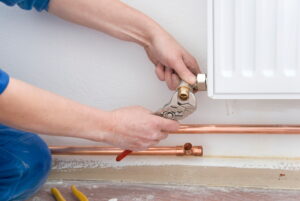Copper pipes are easily some of the best plumbing materials on the market. There’s just nothing quite like copper when it comes to the strength, malleability, and affordability of it.
However, just like any material that’s in constant contact with water, eventually it will start to corrode and lose integrity. This is inevitable, but your next plumbing disaster doesn’t have to be.
Today, we’re going to give homeowners some tips about detecting copper pipe corrosion. This can be as simple as detecting certain symptoms on or around your plumbing appliances, or as complex as hiring a professional for maintenance to get an in-depth look.
Either way, copper pipe corrosion in Cleves, OH is a real problem and one that we aim to make homeowners very aware of in the coming months.
So, buckle up and make sure you’ve got a local professional plumber’s number on hand for when you detect any problem in the future.
Blue-Green Stains on Plumbing Appliances
The first easy-to-notice sign of copper pipe corrosion is a blue-green stain that you might see on plumbing appliances. These appliances include sinks, faucets, toilets, showers, tubs, and water heaters that might be connected to copper pipes.
The reasoning for the appearance of this blue-green stain is pretty simple. When copper dissolves into water, it turns blue-green in hue and travels through the waterway until it reaches a certain point where it’s deposited.
Sometimes it can be deposited into a sink, other times onto a showerhead. But these are actually microscopic bits of your copper pipe being deposited somewhere else, which means that the structural integrity of your copper pipes is in rough shape.
These deposits are usually pretty easy to clean, but they shouldn’t be brushed aside. Make sure you let your plumber know that you found these so they can try to identify the pipes that are failing.
Pinhole Leaks
Pinhole leaks don’t happen often, but they do in pipes that are corroding. This is because pinhole leaks require a very thin or corroded pipe surface to start leaking.
Go around the pipes that you have in your house and inspect them. If you notice a droplet forming on your pipe that seems to leak to the floor, then this could be a pinhole leak.
Don’t be mistaken, pinhole leaks are very bad even if they don’t look too bad. They might not waste a lot of water in the moment, but because they’re easy to miss, they can waste a lot of water in the long run while they work behind the scenes to drip water into areas of your home.
General Roughness
Generally, a corroded pipe is going to look a lot rougher around the edges than a pipe that’s new or in good shape. You’ll probably easily detect which pipes are corroding simply by looking at them and detecting a bit of a rust color or a blue-green shade to them.
A plumbing professional can help walk around your property with you and detect corroding pipes so they can be replaced quickly and easily.
It’s time to contact Ken Neyer Plumbing, Inc. to have your plumbing pipes repaired.

